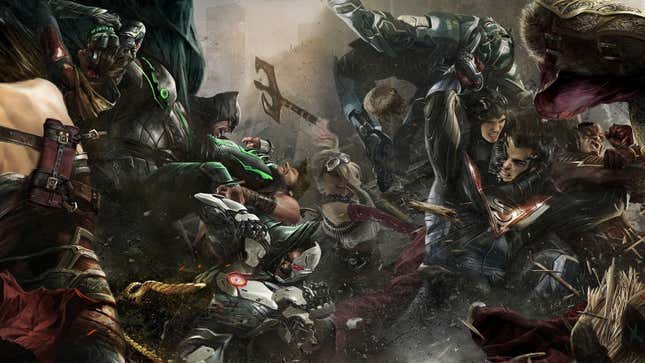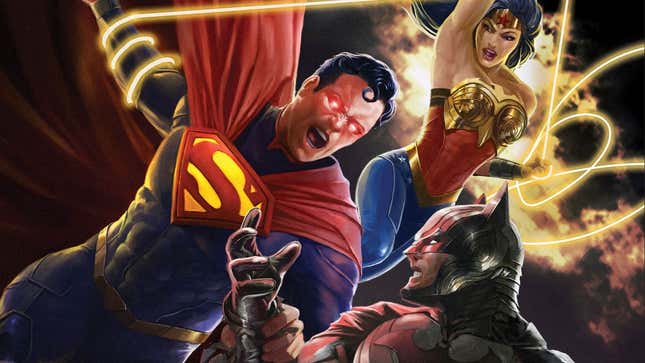Superheroes have been punching each other in their face for decades, and doing that in video games almost as long. Every once in a while, the superhero genre crosses over into the fighting game space, resulting in the likes of the Marvel vs. Capcom series and appreciated jams like Teen Titans: Battle Blitz and X-Men: Children of the Atom.
Warner Bros. eventually got in on that action with 2008’s Mortal Kombat vs. DC Universe from Midway. Five years later and following a rebrand to NetherRealm, a second attempt was made with Injustice. The original game, Gods Among Us, released on April 16, 2013 with what was then the groundbreaking story pitch of resistance leader Batman and dictator Superman fighting each other and conscripting various DC characters to join their respective sides. That alone would be a substantial hook, but the game went even further by having the alt-universe Batman call in a Justice League from a separate universe (aka, the “correct” one where Superman isn’t evil) to help out with the resistance effort.
Advertisement

At the time before its release, it wasn’t fully clear just what to make of Injustice 1. Certainly part of that was its elevator pitch; its alt-universe take on DC characters seemed almost groanworthy, particularly when its “Evil Superman” hook was revealed to have been incited by him killing his pregnant wife Lois Lane (on accident) and the Joker (intentional). Beyond that, NetherRealm had only just righted the ship of its Mortal Kombat franchise with the 2011 reboot, and MK vs. DC having a mixed response from critics and players alike. With Gods Among Us, the reception was much more favorable, with praise for both its story and gameplay mechanics.
Advertisement
Advertisement
DC seemed to know that NetherRealm had a hit on its hands, and did what it could to sell Injustice as more than a simple alternate universe. Months before the release of Gods Among Us, it released a comic book prequel series from Tom Taylor and Jeremy Raapack. The comic continued for years following the game’s release under a different creative team, while continuing to sketch out the world. It helped that the issues released in cheaper bite-sized chunks online before coming in physical formats, allowing DC to hit audiences who might not have otherwise gone to a comic store to pick it up.
The allure of Injustice varies for everyone, but I think the general draw comes from how much it commits to its own nonsense. Like with Mortal Kombat, NetherRealm managed to key in on the inherent appeal of turning superhero brawls into even more bombastic wrestling matches, and allowed that dumb energy to run through all parts of the game. It’s more noticeable in 2017’s Injustice 2; from the game’s customization options to the way characters banter back and forth, it all feels like it’s playing in the juvenile space that makes cape comics so endearing. Yes, it’s a little messed up when Superman melts Shazam’s brain or Tim Drake dies five seconds after being reunited with Batman…but it’s also kinda funny, right?
Advertisement

Again, DC seems to think so. Not only did it release another comic book series that filled in the narrative between the two Injustice games, it went even further with a comic book crossover involving He-Man and getting both the Ninja Turtles and Hellboy to pop into Injustice 2 as guest characters. In 2021, Warner Bros. released an animated film adaptation of the original game, and Evil Superman has recently popped up in the orbit of Superman’s son Jon Kent from the main DC Comics universe. Attempts have also been made to replicate Injustice’s success, to some degree or another. The recent alt-universe stories DCeased and Dark Knights of Steel (both written by Taylor and respectively drawn by Trevor Hairsine and Yasmine Putri) feel like they’re playing in a similar space, intentionally or otherwise. Time will tell if either of those take off in the same way, though.
Advertisement
It wouldn’t entirely be wrong to say Injustice is the healthiest sub-franchise of DC’s stable, if only because no one at Warner Bros. seems to be greatly overthinking it. Beyond that, the series’ best asset may just be that it came in the mid-2010s. Dickhead Superman felt quaint back then, and it also came out months before Man of Steel made the idea of discussing a jerk Clark an exhausting prospect. Had the game come out years later, there’s a good chance it still would’ve thrived; NetherRealm makes generally great work, and people like playing games where they can punch their friends into or through walls. But not unlike an expert in the fighting game community, NetherRealm saw an opening with Injustice to hit hard and not let up one bit.
Want more io9 news? Check out when to expect the latest Marvel, Star Wars, and Star Trek releases, what’s next for the DC Universe on film and TV, and everything you need to know about the future of Doctor Who.
Services Marketplace – Listings, Bookings & Reviews